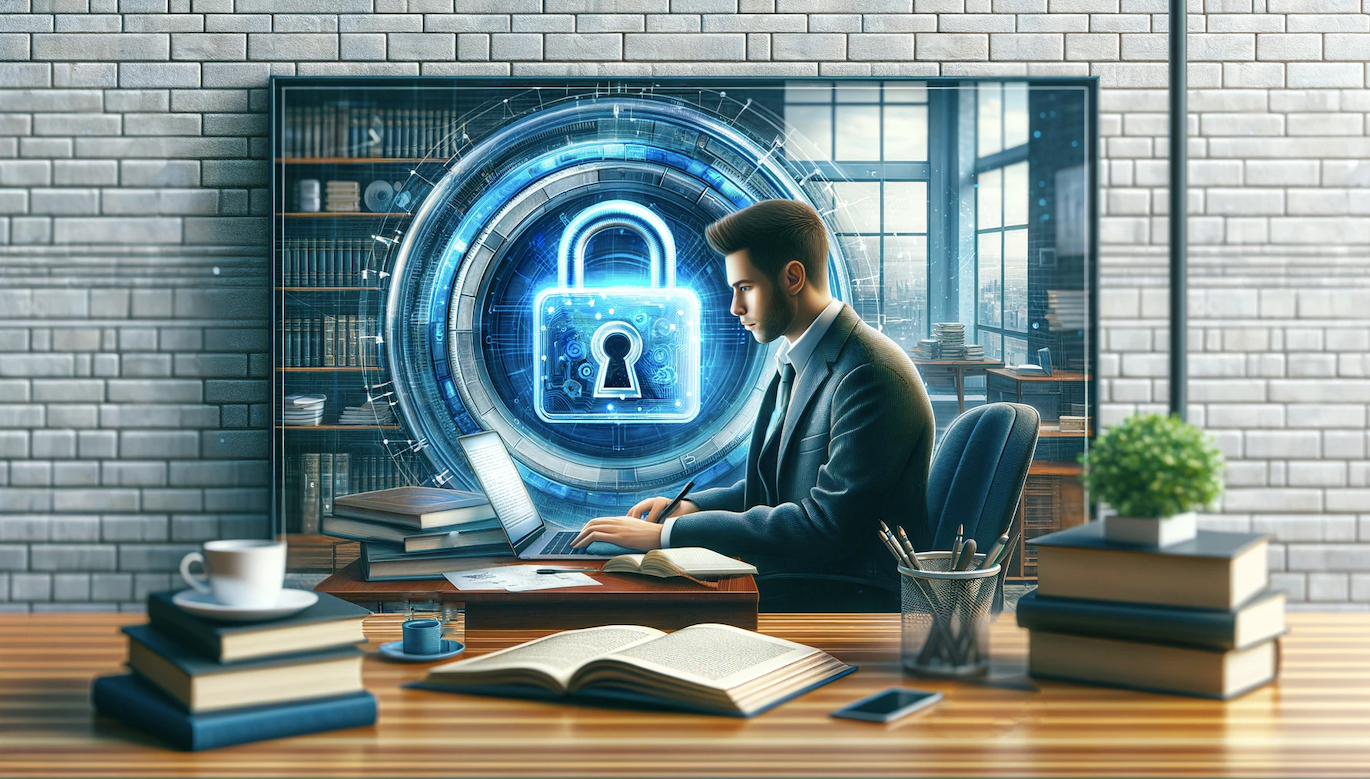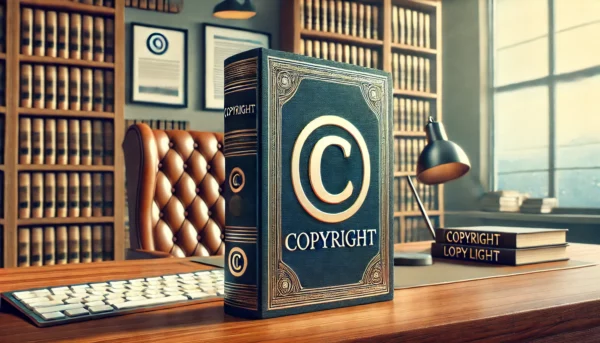In the digital age, where content is easily accessible and widely distributed, protecting intellectual property has become a significant challenge for authors. Understanding copyrights and licences is essential. Digital Rights Management (DRM) is a set of technologies designed to control the use of digital content and devices after the initial sale. DRM encompasses a variety of methods, including encryption, digital watermarking, and access control, to prevent unauthorized use and distribution of digital media.
For modern authors, DRM is crucial because it safeguards their creative works from piracy and unauthorized reproduction. By ensuring that only authorized users can access their content, DRM helps maintain the integrity and value of intellectual property, thereby protecting the revenue streams that authors depend on. This protection is not just limited to books but extends to all forms of digital content, including audio files, videos, and sensitive documents.
This article delves into the world of DRM, exploring its technologies, the role it plays in protecting digital content, and its significance in managing digital assets. We will discuss the implementation of DRM solutions, their impact on the media and entertainment industry, and the challenges and controversies surrounding these technologies. By the end of this article, authors will have a comprehensive understanding of how DRM works and why it is essential in the digital marketplace.
DRM Technologies
Digital Rights Management (DRM) technologies are essential tools for protecting digital content from unauthorized use and distribution. These technologies employ various methods to control access, manage permissions, and ensure that only authorized users can interact with digital media. Here, we will explore several key DRM technologies, including digital watermarking, encryption and decryption keys, access control mechanisms, and DRM software and systems, providing examples of their application in today’s digital landscape.
Overview of Different DRM Technologies
DRM technologies are designed to protect digital content through a combination of methods that restrict access and usage. These technologies aim to prevent unauthorized copying, sharing, and distribution, thereby safeguarding intellectual property and revenue streams for content creators.
Digital Watermarking
Digital watermarking is a technique used to embed a unique identifier into digital content, such as images, videos, and audio files. This identifier is usually invisible to the user but can be detected using specialized software. Watermarking serves several purposes:
- Tracking and Identification: Watermarks can help track the distribution of content and identify the source of unauthorized copies.
- Proof of Ownership: They provide proof of ownership and can be used in legal proceedings to assert intellectual property rights.
- Deterrence: The presence of a watermark can deter potential infringers by signaling that the content is protected.
Examples of digital watermarking in use today include the identification of original copies of eBooks, tracking the distribution of music files, and protecting digital artwork from being reproduced without permission.
Encryption and Decryption Keys
Encryption is a fundamental DRM technology that protects digital content by converting it into a coded format that can only be accessed by authorized users with the correct decryption key. This process involves:
- Encrypting Content: Transforming digital content into an unreadable format using an encryption algorithm and a key.
- Distributing Keys: Providing decryption keys to authorized users, often through secure channels.
- Decrypting Content: Allowing authorized users to convert the content back into its original, readable format using the decryption key.
Encryption ensures that even if unauthorized users gain access to the digital files, they cannot view or use the content without the decryption key. This technology is widely used in applications such as secure streaming services, encrypted eBooks, and protected software downloads.
Access Control Mechanisms
Access control mechanisms manage who can access and use digital content based on predefined permissions. These mechanisms include:
- User Authentication: Verifying the identity of users before granting access to content. This can involve passwords, biometrics, or multi-factor authentication.
- Licensing Agreements: Defining the terms and conditions under which content can be accessed and used. These agreements specify usage rights, such as the number of devices that can access the content or the duration of access.
- Usage Restrictions: Implementing limitations on how content can be used, such as preventing copying, printing, or sharing.
Access control mechanisms are integral to DRM systems, ensuring that only authorized users can access digital content under specific conditions.
DRM Software and Systems
DRM software and systems provide the infrastructure to manage and enforce digital rights. These tools include:
- Content Management Systems (CMS): Platforms that organize, store, and distribute digital content while enforcing DRM policies.
- Digital License Management (DLM): Systems that manage the distribution of licenses and keys to authorized users.
- Secure Distribution Platforms: Services that deliver digital content securely, ensuring that DRM protections are in place.
Examples of DRM software and systems in use today include Adobe Digital Editions for eBooks, Apple’s FairPlay for iTunes content, and Microsoft’s PlayReady for streaming video.
Examples of DRM Technologies in Use Today
Several industries rely on DRM technologies to protect their digital content:
- eBooks: Amazon’s Kindle platform uses DRM to restrict unauthorized copying and sharing of eBooks.
- Music: Services like Spotify and Apple Music use DRM to control access to their streaming libraries.
- Video: Netflix and Hulu implement DRM to prevent unauthorized downloading and sharing of their video content.
- Software: Many software companies use DRM to protect their applications from piracy, requiring activation keys and online verification.
DRM technologies, including digital watermarking, encryption, access control mechanisms, and specialized software, play a crucial role in protecting digital content in today’s digital marketplace. These technologies ensure that content creators can control access, manage usage, and protect their intellectual property from unauthorized distribution.
Protecting Digital Content
Digital Rights Management (DRM) plays a crucial role in safeguarding digital content from unauthorized use and distribution. By employing various technologies and strategies, DRM helps protect digital media and intellectual property, ensuring that content creators retain control over their work and its distribution. In this section, we will explore how DRM protects digital content, prevents unauthorized distribution and copying, and the role of DRM restrictions in content protection.
How DRM Protects Digital Content
DRM employs a combination of technologies to protect digital content from unauthorized access and use. These technologies include encryption, digital watermarking, and access control mechanisms. By encrypting content, DRM ensures that only users with the appropriate decryption keys can access the material. Digital watermarking embeds unique identifiers into the content, allowing content creators to track and identify unauthorized copies. Access control mechanisms manage user permissions, ensuring that only authorized individuals can access and use the content.
DRM systems enforce these protections by integrating them into the content distribution process. For example, when a user purchases an eBook, the DRM system encrypts the file and provides a decryption key that is unique to the user. This key is tied to the user’s account and devices, preventing unauthorized sharing of the file.
Protecting Digital Media and Intellectual Property
Digital media, including eBooks, music, videos, and software, represent valuable intellectual property for content creators. DRM helps protect this intellectual property by:
- Restricting Access: Only authorized users can access DRM-protected content, ensuring that it is not freely available for unauthorized use.
- Managing Permissions: DRM systems define and enforce usage permissions, such as limiting the number of devices that can access the content or preventing actions like copying, printing, or sharing.
- Tracking Usage: Digital watermarking allows content creators to track the distribution and usage of their content, providing insights into potential unauthorized access.
By protecting digital media and intellectual property, DRM helps content creators maintain control over their work, ensuring that they receive appropriate compensation and recognition for their efforts.
Preventing Unauthorized Distribution and Copying
One of the primary goals of DRM is to prevent unauthorized distribution and copying of digital content. DRM achieves this through several mechanisms:
- Encryption: By encrypting digital content, DRM ensures that only users with the correct decryption keys can access the material. This prevents unauthorized users from viewing or distributing the content.
- Usage Restrictions: DRM systems impose restrictions on how content can be used. For example, DRM can prevent users from copying and pasting text from an eBook, burning music files to a CD, or sharing a video file with others.
- License Management: DRM systems use licenses to control access to digital content. These licenses specify the terms and conditions under which the content can be used, such as the duration of access or the number of devices that can access the content.
These mechanisms help prevent unauthorized distribution and copying, ensuring that digital content remains secure and protected.
DRM Restrictions and Their Role in Content Protection
DRM restrictions are essential for maintaining the security and integrity of digital content. These restrictions help protect content in several ways:
- Limiting Access: DRM restrictions ensure that only authorized users can access the content, preventing unauthorized individuals from viewing or distributing it.
- Controlling Usage: By defining and enforcing usage permissions, DRM restrictions prevent users from performing actions that could lead to unauthorized distribution, such as copying, printing, or sharing the content.
- Enforcing Compliance: DRM restrictions ensure that users comply with the terms and conditions set by content creators and distributors, helping to protect intellectual property rights and revenue streams.
While DRM restrictions can sometimes be viewed as limiting user experience, they are essential for protecting digital content and ensuring that content creators retain control over their work.
Overall, DRM is a vital tool for protecting digital content from unauthorized access and distribution. By employing technologies such as encryption, digital watermarking, and access control mechanisms, DRM ensures that digital media and intellectual property remain secure. DRM restrictions play a crucial role in maintaining this security, helping to prevent unauthorized copying and distribution while protecting the rights and revenue of content creators.
Intellectual Property in the Digital World
In the digital age, intellectual property rights are more critical than ever in protecting the creations of authors, artists, and innovators. These rights ensure that creators maintain control over their work and are fairly compensated for their efforts. This section defines intellectual property rights, explains their importance, explores how DRM supports intellectual property protection, discusses the relationship between copyright laws and DRM, and outlines strategies for authors to protect their intellectual property.
Definition and Importance of Intellectual Property Rights
Intellectual property (IP) rights are legal protections granted to creators for their original works. These rights include copyrights, trademarks, patents, and trade secrets, each serving to protect different types of intellectual creations. For authors, copyrights are particularly important as they grant exclusive rights to reproduce, distribute, perform, display, and create derivative works based on their original content.
The importance of IP rights lies in their ability to:
- Incentivize Creativity: By granting creators exclusive rights, IP laws encourage innovation and the production of new works.
- Economic Value: IP rights allow creators to monetize their work, generating income through sales, licensing, and other commercial activities.
- Control and Recognition: IP rights ensure that creators retain control over how their work is used and distributed, and receive appropriate credit and recognition.
How DRM Supports Intellectual Property Protection
Digital Rights Management (DRM) plays a crucial role in supporting intellectual property protection by providing technological solutions to enforce IP rights in the digital realm. DRM technologies help protect digital content from unauthorized use and distribution through methods such as:
- Encryption: Ensures that only authorized users can access the content.
- Access Control: Manages permissions to control how and by whom the content can be used.
- Digital Watermarking: Embeds identifiers to track and identify unauthorized copies.
By implementing these technologies, DRM helps maintain the integrity of digital content and ensures that only those with proper authorization can access and use it, thus protecting the creator’s intellectual property rights.
Copyright Laws and DRM
Copyright laws are the legal foundation that grants authors exclusive rights to their works. These laws are designed to protect the interests of creators by giving them control over the use and distribution of their content. DRM technologies complement copyright laws by providing the means to enforce these rights in the digital environment.
For example, copyright laws may grant an author the exclusive right to distribute their eBook, but without DRM, it would be challenging to prevent unauthorized copying and sharing. DRM technologies enable authors to enforce their copyright rights by restricting how their digital content is accessed and used.
Intellectual Property Protection Strategies for Authors
Authors can adopt several strategies to protect their intellectual property in the digital world:
- Use DRM Technologies: Implement DRM solutions to control access, prevent unauthorized distribution, and manage permissions for digital content.
- Register Copyrights: Ensure that their works are legally protected by registering copyrights with the relevant authorities.
- Monitor and Enforce Rights: Actively monitor the use of their content and take legal action against infringers when necessary.
- Educate Themselves: Stay informed about the latest developments in IP laws and DRM technologies to effectively protect their work.
In conclusion, intellectual property rights are essential for safeguarding the creations of authors in the digital world. DRM technologies provide robust tools to support IP protection by enforcing access controls, preventing unauthorized use, and ensuring compliance with copyright laws. By leveraging these technologies and adopting proactive strategies, authors can protect their intellectual property and ensure that their creative efforts are justly rewarded.
Implementing DRM Solutions
Implementing Digital Rights Management (DRM) solutions is essential for protecting digital content and ensuring that only authorized users can access and use it. This section outlines the steps to implement DRM solutions, choosing the right DRM system, best practices for DRM implementation, and common challenges along with strategies to overcome them.
Steps to Implement DRM Solutions
1. Assess Needs and Objectives: Identify the specific needs and objectives for DRM implementation. Determine what types of digital content need protection, the level of security required, and the desired user experience.
2. Select a DRM System: Choose a DRM system that aligns with your needs. Consider factors such as the types of content it supports, the level of security it offers, and its compatibility with your existing infrastructure.
3. Integrate DRM Technology: Integrate the chosen DRM technology into your content distribution platforms. This involves setting up encryption, access controls, and digital watermarking as needed.
4. Define Usage Policies: Establish clear usage policies that outline how content can be accessed and used. These policies should specify restrictions such as the number of devices allowed, duration of access, and limitations on copying and sharing.
5. Implement Licensing Management: Set up a licensing management system to handle the distribution of licenses and keys to authorized users. Ensure that the system can manage renewals, expirations, and revocations efficiently.
6. Test and Monitor: Test the DRM implementation thoroughly to identify any potential issues. Monitor the system continuously to ensure it is functioning as expected and to detect any unauthorized access attempts.
Choosing the Right DRM System
Choosing the right DRM system is crucial for effective protection. Consider the following factors:
- Content-Type: Ensure the DRM system supports the specific types of digital content you need to protect (e.g., eBooks, videos, music).
- Security Level: Evaluate the security features of the DRM system, including encryption standards and access control mechanisms.
- Usability: Choose a system that offers a balance between security and ease of use for end-users.
- Scalability: Ensure the DRM solution can scale with your growing content library and user base.
Best Practices for DRM Implementation
- User-Friendly Design: Implement DRM in a way that minimizes inconvenience for legitimate users while maintaining strong security.
- Regular Updates: Keep the DRM system updated to address new security threats and vulnerabilities.
- Clear Communication: Inform users about the DRM policies and how they affect content access and usage.
- Data Privacy Compliance: Ensure that the DRM implementation complies with data protection regulations and respects user privacy.
Common Challenges and How to Overcome Them
- User Frustration: Users may find DRM restrictions cumbersome. Overcome this by designing intuitive interfaces and providing clear guidance on accessing and using protected content.
- Technical Integration: Integrating DRM with existing systems can be complex. Work with experienced DRM providers and invest in thorough testing to ensure seamless integration.
- Evolving Threats: DRM systems must adapt to new piracy methods. Regularly update the DRM software and stay informed about emerging threats.
In conclusion, implementing DRM solutions involves careful planning, selecting the right system, and adhering to best practices to protect digital content effectively. By addressing common challenges proactively, content creators can ensure robust protection while maintaining a positive user experience.
DRM in the Media and Entertainment Industry
Digital Rights Management (DRM) is a critical tool for media and entertainment companies, ensuring that their content is protected from unauthorized access and distribution. In an industry where digital content is both a primary product and a valuable asset, DRM plays a vital role in safeguarding intellectual property, controlling distribution, and maximizing revenue.
Importance of DRM for Media and Entertainment Companies
For media and entertainment companies, DRM is essential to protect their digital assets, including movies, music, eBooks, and software. These assets represent significant investments in terms of time, money, and creative effort. Without robust DRM measures, these companies risk losing revenue to piracy and unauthorized distribution, which can severely impact their profitability and market position.
How DRM Helps in Controlling Access and Distribution
DRM technologies enable media and entertainment companies to control who can access their content and how it is used. Key methods include:
- Encryption: Protects digital content by ensuring that only authorized users with the correct decryption keys can access it.
- Access Control: Manages permissions and user authentication to restrict content access to authorized individuals.
- Usage Restrictions: Limits actions such as copying, sharing, and printing, ensuring that content is used in accordance with licensing agreements.
By implementing these DRM measures, companies can prevent unauthorized access and distribution, maintaining control over their digital content, and protecting their intellectual property.
Case Studies/Examples from the Industry
Several media and entertainment companies have successfully implemented DRM to protect their content:
- Netflix: Utilizes DRM to secure its streaming library, ensuring that only subscribers can access its content and preventing unauthorized downloads and distribution.
- Spotify: Employs DRM to protect its music streaming service, allowing users to listen to music while preventing illegal copying and sharing of tracks.
- Adobe Digital Editions: Provides DRM for eBooks, ensuring that only authorized users can access and read purchased digital books.
These examples demonstrate how DRM helps these companies control access and distribution, protect their content, and maintain their revenue streams.
Impact on Revenue and Content Security
DRM has a significant impact on revenue and content security for media and entertainment companies. By preventing unauthorized access and distribution, DRM helps these companies:
- Maximize Revenue: By ensuring that only paying customers can access their content, DRM helps to secure revenue streams that would otherwise be lost to piracy.
- Protect Intellectual Property: DRM safeguards the creative works of artists and producers, ensuring that their content is not exploited without permission.
- Enhance Market Trust: Implementing robust DRM measures can enhance consumer trust, as users know that their purchases are protected and the content creators are fairly compensated.
In conclusion, DRM is indispensable for media and entertainment companies, providing essential protection for digital content, controlling access and distribution, and securing revenue. By leveraging DRM technologies, these companies can safeguard their intellectual property, maintain market trust, and ensure their continued success in the digital marketplace.
Challenges and Controversies of DRM
Digital Rights Management (DRM) technologies, while crucial for protecting digital content, have faced significant criticisms and controversies. This section explores common criticisms of DRM, issues related to user experience and access, the balance between protection and accessibility, and the future outlook for DRM technologies.
Common Criticisms of DRM
Critics argue that DRM often imposes overly restrictive controls that hinder the legitimate use of digital content. Some of the most common criticisms include:
Inconvenience: DRM can create hurdles for legitimate users, requiring constant internet access, multiple authentications, and limiting the number of devices that can access the content.
Compatibility Issues: DRM-protected content may not be compatible with all devices or software, restricting how users can enjoy their purchases.
Consumer Rights: Some argue that DRM infringes on consumer rights, such as the ability to make personal backup copies of legally purchased content.
Issues Related to User Experience and Access
DRM can negatively impact user experience by creating barriers to accessing and using digital content. For instance, users may experience:
Limited Accessibility: Restrictions on copying and sharing can prevent users from enjoying content across multiple devices or sharing with family members.
Technical Problems: DRM systems can introduce technical issues, such as playback problems or difficulty accessing content after changing devices or accounts.
The Balance Between Protection and Accessibility
Finding a balance between protecting content and providing a seamless user experience is a significant challenge for DRM developers. Effective DRM solutions need to:
- Ensure Security: Protect content from unauthorized access and distribution.
- Maintain Usability: Provide a smooth and flexible user experience without imposing excessive restrictions.
Future Outlook for DRM Technologies
The future of DRM technologies will likely focus on enhancing both security and user experience. Innovations may include:
- Improved Interoperability: Developing DRM systems that work seamlessly across different devices and platforms.
- User-Centric Design: Creating DRM solutions that prioritize ease of use while maintaining robust security.
- Advanced Technologies: Leveraging AI and blockchain to provide more sophisticated and user-friendly DRM protections.
While DRM is essential for protecting digital content, it must evolve to address criticisms and improve the balance between security and accessibility. Future advancements in DRM technologies hold promise for more effective and user-friendly solutions.
Conclusion
Digital Rights Management (DRM) is essential for modern authors in the digital age. By safeguarding digital content from unauthorized use and distribution, DRM ensures that authors maintain control over their creative works and receive proper compensation. It plays a critical role in protecting intellectual property, securing revenue streams, and enhancing the value of digital assets.
DRM technologies such as encryption, digital watermarking, and access control mechanisms provide robust solutions for content protection. While DRM has faced criticisms related to user experience and accessibility, it remains a vital tool in the fight against piracy and unauthorized distribution. As DRM technologies evolve, they promise to strike a better balance between protection and usability, benefiting both content creators and consumers.
For authors, adopting DRM solutions is a proactive step towards securing their intellectual property in the digital world. By leveraging these technologies, authors can ensure that their works are protected, their rights are enforced, and their creative efforts are rewarded. In an increasingly digital marketplace, DRM is not just a protective measure but a necessity for sustaining and enhancing the value of one’s intellectual creations.







